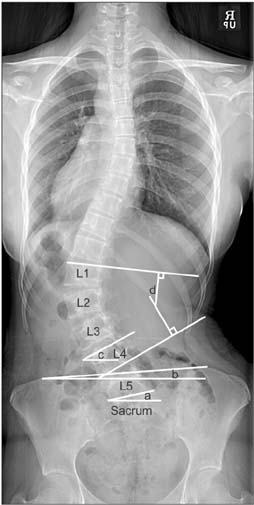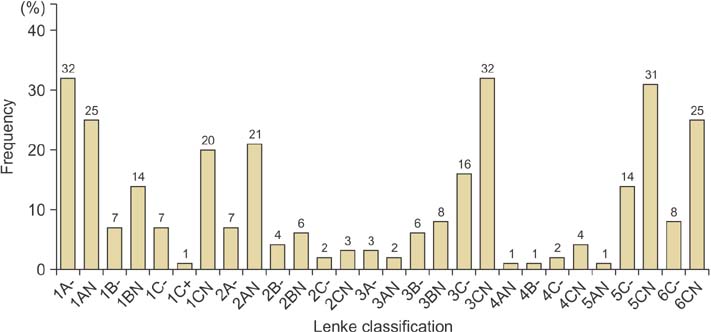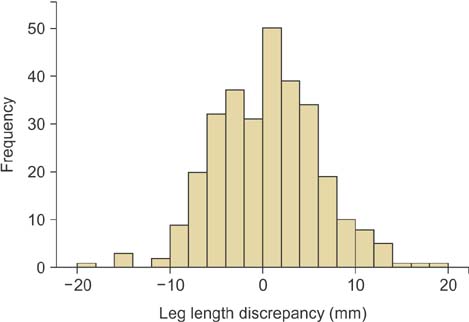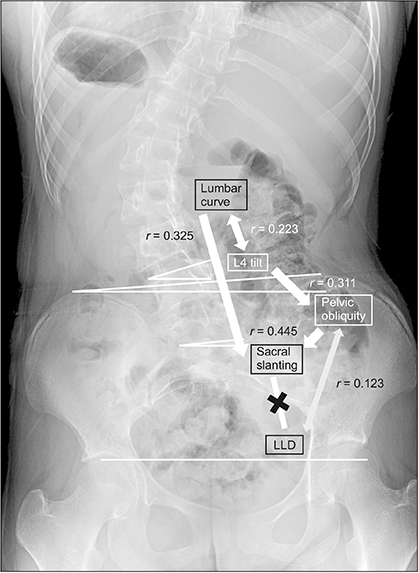Clin Orthop Surg.
2017 Mar;9(1):57-62. 10.4055/cios.2017.9.1.57.
Association between Sacral Slanting and Adjacent Structures in Patients with Adolescent Idiopathic Scoliosis
- Affiliations
-
- 1Department of Orthopedic Surgery, Asan Medical Center, University of Ulsan College of Medicine, Seoul, Korea. spinecjh@gmail.com
- KMID: 2412304
- DOI: http://doi.org/10.4055/cios.2017.9.1.57
Abstract
- BACKGROUND
Sacral slanting is a frequent unique phenomenon in patients with adolescent idiopathic scoliosis (AIS) and may be important for selecting the distal fusion level. However, the reason of the phenomenon remains unknown. The purpose of this study was to determine the association between sacral slanting and adjacent structures in patients with AIS.
METHODS
A total of 303 AIS patients who underwent both whole spine standing anteroposterior (AP) and whole leg standing AP radiography were included. The degree of sacral slanting, pelvic obliquity, lumbar curve angles (L1-L4), and L4 tilt were assessed on whole spine standing AP radiographs. Whole leg standing AP radiographs were used to assess the degree of leg length discrepancy (LLD). Demographic data and radiological parameters were analyzed descriptively. Pearson correlation analysis and partial correlation analysis of the parameters were performed. A p-value of less than 0.05 was considered statistically significant.
RESULTS
The proportion of patients with ≥ 5° of sacral slanting among those with < 3° of pelvic obliquity was 8.9% (27/303). Thirty-two patients (10.6%, 32/303) showed more than 10 mm of LLD. Sacral slanting was positively correlated with pelvic obliquity and lumbar curve (r = 0.445 and r = 0.325, respectively). Pelvic obliquity was also correlated with LLD and L4 tilt (r = 0.123 and r = 0.311, respectively). However, partial correlation analysis showed that LLD was not directly correlated with sacral slanting (r = −0.034).
CONCLUSIONS
Sacral slanting can be thought to be a compensatory mechanism for large lumbar curves, which is accompanied by pelvic obliquity. In contrast, a congenitally slanted upper sacrum may contribute to scoliosis in some cases. LLD was not directly correlated with sacral slanting.
Keyword
MeSH Terms
Figure
Reference
-
1. Lee CS, Ha JK, Kim DG, et al. The clinical importance of sacral slanting in patients with adolescent idiopathic scoliosis undergoing surgery. Spine J. 2015; 15(5):834–840.
Article2. Needham R, Chockalingam N, Dunning D, Healy A, Ahmed EB, Ward A. The effect of leg length discrepancy on pelvis and spine kinematics during gait. Stud Health Technol Inform. 2012; 176:104–107.3. Cummings G, Scholz JP, Barnes K. The effect of imposed leg length difference on pelvic bone symmetry. Spine (Phila Pa 1976). 1993; 18(3):368–373.
Article4. King HA, Moe JH, Bradford DS, Winter RB. The selection of fusion levels in thoracic idiopathic scoliosis. J Bone Joint Surg Am. 1983; 65(9):1302–1313.
Article5. Lenke LG, Betz RR, Harms J, et al. Adolescent idiopathic scoliosis: a new classification to determine extent of spinal arthrodesis. J Bone Joint Surg Am. 2001; 83(8):1169–1181.6. Raczkowski JW, Daniszewska B, Zolynski K. Functional scoliosis caused by leg length discrepancy. Arch Med Sci. 2010; 6(3):393–398.7. Zabjek KF, Leroux MA, Coillard C, et al. Acute postural adaptations induced by a shoe lift in idiopathic scoliosis patients. Eur Spine J. 2001; 10(2):107–113.
Article8. Betsch M, Rapp W, Przibylla A, et al. Determination of the amount of leg length inequality that alters spinal posture in healthy subjects using rasterstereography. Eur Spine J. 2013; 22(6):1354–1361.
Article9. Timgren J, Soinila S. Reversible pelvic asymmetry: an overlooked syndrome manifesting as scoliosis, apparent leg-length difference, and neurologic symptoms. J Manipulative Physiol Ther. 2006; 29(7):561–565.
Article
- Full Text Links
- Actions
-
Cited
- CITED
-
- Close
- Share
- Similar articles
-
- Does Sacral Slanting Affect Postoperative Shoulder Balance in Patients With Lenke Type 2A Adolescent Idiopathic Scoliosis?
- Spontaneous Rib Fracture during Boston Brace Treatment for Adolescent Idiopathic Scoliosis
- Etiology of Adolescent Idiopathic Scoliosis: A Literature Review
- The Classification of Idiopathic Scoliosis
- Body Mass Index and Bone Mineral Densityin Patients with Adolescent Idiopathic Scoliosis





